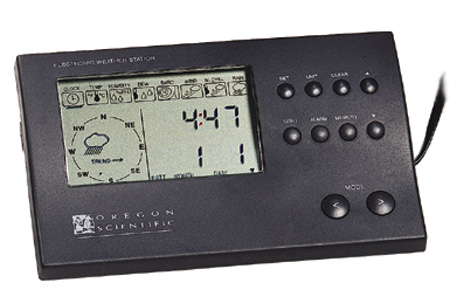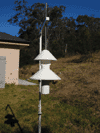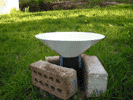|
|
This AWS is powered by an Oregon Scientific WM-918 Automatic Weather Station
Data is collected and stored using Ambients Virtual Weather Station.
|

|
|
This Weather Station includes these sensors:
|
 |
The Thermo-Hygrometer
 The Thermo-Hygrometer measures outdoor temperature and relative humidity. Updating of information to the display unit occurs every 10-seconds.
The Thermo-Hygrometer measures outdoor temperature and relative humidity. Updating of information to the display unit occurs every 10-seconds.
The temp/hygro sensor has been placed within a custom made forced aspirated radiation shield, this shield greatly reduces any errors caused by solar
radiation by ensuring the air sample is as true as possible to the outside air, this is achieved by fan forced cooling and also by double insulation where the shield is double walled
with the outer and inner chambers being exhausted by a fan, the inner tube carries the air sample whereas the outer tube acts as a thermal isolator, this helps exhaust any heat on the outer chamber from affecting the air
sample within the inner chamber, the airflow through
the shield is around 4m/s. This screen is 1.5m off the surface, adjustable via the threaded connecting rod on top of the screen.
|
 |
The Anemometer
The anemometer measures wind speed and direction. The anemometer wind speed operating range is up to 200kph and has a accuracy resolution of +/- (plus or minus) 0.64kph. In steady wind conditions the anemometer transmits new readings to the display unit once every minute; in gusty conditions, gust updating occurs every 14-seconds. Wind direction operating range is 0° to 359°. Data transmission to the display unit occurs every 5-seconds.
|
 |
The Rain Gauge
The Rain Gauge measures rainfall in 1.0 millimeter increments reflecting current rainfall or accumulation, the unit stores total rain fall from the last time the unit was reset. The Rain Gauge features a self-emptying rain collection unit which provides a pulse each time the corresponding unit of rain is measured. Daily rainfall sampling rate is every 24-hours, rainfall rate is at every tipping interval.
Note, This rain gauge has been modified to record 0.1mm rain increments, this
has been acheived by the fitting of a larger rain collector, 37.6cm in diameter is required to achieve a collection area of 10x that of the original, the drawback of this is that the display console becomes worthless at the with the 10X amount of water flowing through it (compensated in software) with the maximum rainrate now
only being around 99mm/h, there is also now a larger surface area to have to wet before the water starts to run down the funnel, this amount also tends to be left in the funnel after a fall and is lost to evaporation, this can now
be offset by the fact that the funnel now collects a larger amount of water and will provide readings of even the smallest amount of moisture like heavy dew, previously up to 0.9mm could be lost due to the fact that the tipper may have collected 0.9mm but was not enough for the tipper to tip, if there was no subsequent rainfall
then the rain would evaporate from the tipper and the amount lost, losses are now only around 0.2/0.3mm. (the bricks are for grass control only) This rain gauge has been modified to record 0.1mm rain increments, this
has been acheived by the fitting of a larger rain collector, 37.6cm in diameter is required to achieve a collection area of 10x that of the original, the drawback of this is that the display console becomes worthless at the with the 10X amount of water flowing through it (compensated in software) with the maximum rainrate now
only being around 99mm/h, there is also now a larger surface area to have to wet before the water starts to run down the funnel, this amount also tends to be left in the funnel after a fall and is lost to evaporation, this can now
be offset by the fact that the funnel now collects a larger amount of water and will provide readings of even the smallest amount of moisture like heavy dew, previously up to 0.9mm could be lost due to the fact that the tipper may have collected 0.9mm but was not enough for the tipper to tip, if there was no subsequent rainfall
then the rain would evaporate from the tipper and the amount lost, losses are now only around 0.2/0.3mm. (the bricks are for grass control only)
|
| Station Gauge information supplied by Oregon Scientic |
|
|